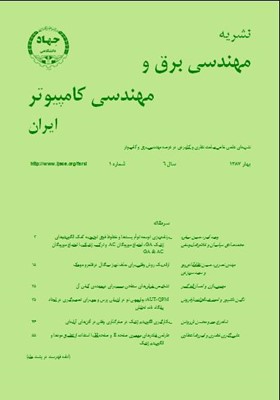بکارگیری الگوریتم ژنتیک در صفرگذاری وفقی در آنتنهای آرايهای
محورهای موضوعی : مهندسی برق و کامپیوتر
1 - دانشگاه صنعتی شیراز
2 - دانشگاه شیراز
کلید واژه: آنتن آرايهایشکلدهی پرتوصفرگذاری وفقیبهینهسازیالگوريتم ژنتيک,
چکیده مقاله :
مقاله حاضر يک روش صفرگذاری وفقی برای آنتنهای آرايهای با استفاده از الگوریتم ژنتیک را ارائه میدهد. در الگوريتم ژنتيک به کار گرفتهشده، تعدادی از بيتهای با کمترين ارزش در انتقالدهندههای فاز کنترل پرتو را برای حداقلکردن مجموع توان خروجی آرايه تنظيم میکند. معيارهای ديگری از قبيل ميانگين مربع خطا و نسبت سيگنال به تداخل به علاوه نويز نيز به کار گرفته شده و با يکديگر مقايسه شده است. استفاده از بيتهای کمارزش باعث ايجاد آشفتگی اندکی در پرتو اصلی الگوی تشعشعی میشود و صفرها را در جهت سيگنالهای تداخلی قرار میدهد. روش جست و جوی دوگانه و جهش وزندار برای کاهش پيچيدگی الگوريتم به کار رفتهاند. همچنين کارآيی الگوريتم ژنتيک با MPDR که يک الگوريتم بهينه برای شکلدهی پرتو است مقايسه شده است. در نهايت نشان داده شده که الگوريتم ژنتيک نسبت به MPDR نتايج بهتری از خود ارائه میدهد.
This paper describes an approach to adaptive nulling with phased arrays. A genetic algorithm adjusts some of the least significant bits of the beam steering phase-shifters to minimize the total output power of the array. Also, some other criterions such as Mean Square Error and Signal to Interference plus Noise Ratio are used and compared with each other. Using the least significant bits results in small perturbation in the main beam of the radiation pattern and puts the nulls in the direction of the interferences. Double search and weighted mutation are used to reduce the complexity of the algorithm. Also, the performance of genetic algorithm is compared with MPDR which is an optimum technique for beamforming. Finally, it is shown that the genetic algorithm performs superior to MPDR.
